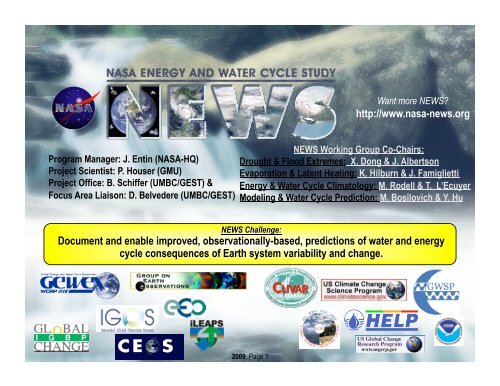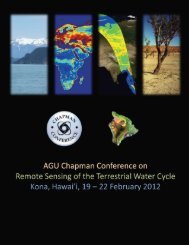Nov 2009 - NEWS (The NASA Energy and Water cycle Study)
Nov 2009 - NEWS (The NASA Energy and Water cycle Study)
Nov 2009 - NEWS (The NASA Energy and Water cycle Study)
You also want an ePaper? Increase the reach of your titles
YUMPU automatically turns print PDFs into web optimized ePapers that Google loves.
Want more <strong>NEWS</strong>?<br />
http://www.nasa-news.org<br />
Program Manager: J. Entin (<strong>NASA</strong>-HQ)<br />
Project Scientist: P. Houser (GMU)<br />
Project Office: B. Schiffer (UMBC/GEST) &<br />
Focus Area Liaison: D. Belvedere (UMBC/GEST)<br />
<strong>NEWS</strong> Working Group Co-Chairs:<br />
Drought & Flood Extremes: X. Dong & J. Albertson<br />
Evaporation & Latent Heating: K. Hilburn & J. Famiglietti<br />
<strong>Energy</strong> & <strong>Water</strong> Cycle Climatology: M. Rodell & T. L’Ecuyer<br />
Modeling & <strong>Water</strong> Cycle Prediction: M. Bosilovich & Y. Hu<br />
<strong>2009</strong>, Page 1
Is the water <strong>cycle</strong> accelerating?<br />
Why study the water & <strong>Energy</strong> <strong>cycle</strong>?<br />
1. <strong>Water</strong> exists in all three phases in the climate<br />
system <strong>and</strong> the phase transitions are a<br />
significant factor in the regulation of the global<br />
<strong>and</strong> regional energy balances<br />
2. <strong>Water</strong> vapor in the atmosphere is the principal<br />
greenhouse gas <strong>and</strong> clouds at various levels <strong>and</strong><br />
composition in the atmosphere represent both<br />
positive <strong>and</strong> negative feedback in climate system<br />
response<br />
3. <strong>Water</strong> is the ultimate solvent <strong>and</strong> global<br />
biogeochemical <strong>and</strong> element <strong>cycle</strong>s are mediated<br />
by the dynamics of the water <strong>cycle</strong><br />
Why <strong>NEWS</strong>?<br />
Need the collective of <strong>NASA</strong> & community<br />
information <strong>and</strong> expertise to ask (<strong>and</strong><br />
define) the larger questions<br />
(aka) Need the whole to be more than the<br />
sum of the parts<br />
4. <strong>Water</strong> is the element of the Earth system that most<br />
directly impacts <strong>and</strong> constraint human society<br />
<strong>and</strong> its well-being.<br />
<strong>2009</strong>, Page 2
<strong>NEWS</strong> Constraints<br />
• Focus on energy <strong>and</strong> water processes <strong>and</strong> dynamics in the climate system.<br />
• <strong>The</strong> <strong>NEWS</strong> challenge is a global scale objective<br />
• Integrate energy <strong>and</strong> water <strong>cycle</strong> system components (observations <strong>and</strong> predictions)<br />
• <strong>NEWS</strong> elements: Observation, Underst<strong>and</strong>ing, Models, Prediction <strong>and</strong> Consequences<br />
• Make decisive progress toward <strong>NEWS</strong> challenge<br />
• <strong>NASA</strong> administers the energy <strong>and</strong> water <strong>cycle</strong> focus area as an end-to-end program<br />
• <strong>NEWS</strong> is an experiment in the power of coordination, integration <strong>and</strong> teamwork<br />
<strong>NEWS</strong> Objectives:<br />
• Develop <strong>and</strong> deploy experimental E&WC global observing system<br />
• Document the global E&WC by obtaining complete observational record of all associated relevant<br />
geophysical properties<br />
• Build fully interactive global climate model that encompasses process-level E&WC forcings <strong>and</strong><br />
feedbacks – Climate models that can predict weather-scale extremes<br />
• Create global surface <strong>and</strong> atmosphere data assimilation system for E&WC variables<br />
• Assess variability of the global E&WC on time scales ranging from seasonal to decadal, <strong>and</strong> space<br />
scales ranging from regional to continental to global<br />
• Support the application of climate prediction capabilities for estimating the impact of climate<br />
variability <strong>and</strong> change on water resources<br />
<strong>2009</strong>, Page 3
-<br />
<strong>2009</strong>, Page 4
-<br />
• Rainfall over eastern Africa <strong>and</strong> the Indian subcontinent are strongly correlated with<br />
patterns in water vapor transport over the Indian ocean; the example above shows<br />
the correlation for Kenya<br />
• Chris Funk is using water vapor transport data developed by <strong>NEWS</strong> to monitor <strong>and</strong><br />
predict rain anomalies over Africa <strong>and</strong> India<br />
• Kyle Hilburn (working with Chris) has developed an experimental version of his<br />
water vapor transport dataset using QuikSCAT data to provide on-going climate<br />
monitoring capabilities updated every 10 days; these data are being evaluated by<br />
Chris<br />
<strong>2009</strong>, Page 5
Science issue: Determine recent climatology of<br />
extremes in precip as a first step in<br />
characterizing the satellite-era record <strong>and</strong><br />
seeking fluctuations/trends<br />
Approach: Test a range of definitions of<br />
“extreme” with high quality satellite data sets<br />
<strong>and</strong> gauge validation<br />
Satellite-based data: TRMM Multi-satellite<br />
Precipitation Analysis (TMPA) 3-hr data<br />
Project status: With funding by <strong>NEWS</strong> <strong>and</strong> PMM,<br />
G.J. Huffman (SSAI; GSFC), R.F. Adler (UMD;<br />
GSFC)<br />
• Developed 11-year climatologies for several<br />
st<strong>and</strong>ard “extremes” variables<br />
• Demonstrated reasonable behavior against 6<br />
years - of gauge data for various climate zones<br />
• Worked to select stable definitions of<br />
“extreme”; generally parameters depending on<br />
a few values<br />
are less stable than<br />
those using more data<br />
• Beginning to examining seasonality of<br />
“extremes” parameters<br />
Huffman, G.J., R.F. Adler, D.T. Bolvin, E.J. Nelkin, 2008: Validation <strong>and</strong> Analysis of<br />
Precipitation Extremes in the TMPA. 4 th Workshop of the IPWG, 13-17 October 2008,<br />
Beijing, China, http://www.isac.cnr.it/~ipwg/ meetings/beijing/4th-IPWG-Proceedings<br />
-web-March-<strong>2009</strong>.pdf, 154-161; http://www.isac.cnr.it/~ipwg/meetings/beijing/pres<br />
/Huffman.ppt.<br />
Avg. Precip (mm/d) 0 3 6 9 12 15+<br />
R95p (mm/d) 0 20 40 60 80 100+<br />
CDDavg (days) 0 100 200 300 400 500+<br />
Example “extremes” in daily precip from the TMPA for 1998-2008:<br />
rain rate for the 95th percentile (R95p; middle); average longest<br />
run of dry days in a year (CDDavg; bottom). Although closely<br />
related to the avg. precip (top), there are important <strong>and</strong><br />
interesting differences, such as the R95p maxima on the<br />
southern coast of Mexico <strong>and</strong> in South America’s la Plata basin,<br />
<strong>and</strong> the small CDDavg gradient in the SPCZ.<br />
<strong>2009</strong>, Page 6












